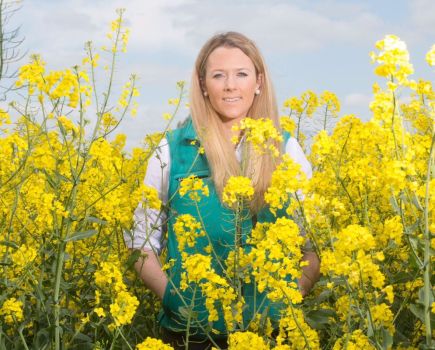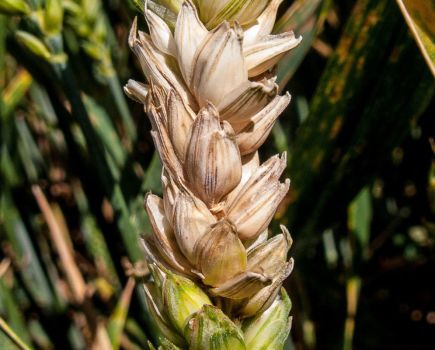Raise the mainsail and cast off because LG Armada is setting sail with the highest yield of any oilseed rape variety, backed up by a hold loaded with traits. CPM goes on a voyage of discovery to explore the map of the variety.
“We’re trying to do everything we can do genetically to make crops easier to manage.”
By Melanie Jenkins
Limagrain’s flagship oilseed rape offering for this season, LG Armada, might be a single variety and not a fleet, but it’s certainly leading the rest of the flotilla.
With the highest yield on the AHDB Recommended List 2024/25 at 106.5%, alongside a plethora of agronomic and disease traits, its breeder hopes it’ll sail to victory. “This is one of the most trait-loaded varieties Limagrain has produced,” says the firm’s Liam Wilkinson. “Armada has pod shatter, TuYV, the Rlm7 gene, stem health characteristics and is the first of our seventh generation of hybrids with the Sclero-flex trait.”
According to Openfield’s Duncan Durno, Armada’s main attribute is its high yield, but the key to this is the traits which support it. “The yield of this variety is so secure because of the traits it has, and this has been proven through its rise to the top of the RL during a number of tricky seasons. I first saw Armada in 2021 and its always stood out for its yield, but it also has impressive growth characteristics meaning it has the whole package.”
Although OSR is an important crop in the UK that can provide strong returns, it can also be a risky crop to grow, says Liam. “One way to manage this risk is to select a variety with as many stacked traits as possible from the beginning, and this is what we’re trying to deliver in our catalogue and especially with Armada.”
Looking at Armada’s stem health traits, it scores 6 against phoma stem canker on the RL, as well as having the Rlm7 gene, and through the Limagrain Sclero-flex system has a quantitative genetic tolerance to sclerotinia, says Liam. “This provides another tool to work with against disease on farm.
“We’re currently seeing situations of a prolonged flowering period because of cabbage stem flea beetle damage, or due to drought or persistent wet conditions, meaning there can sometimes be multiple growth stages in a single field making timing fungicide sprays almost impossible. But with sclerotinia tolerance, this allows a wider window for fungicide applications,” he adds.
“The variety also has good cylindrosporium and verticillium resistance, so we know it provides a robust package and takes as much risk out of managing the crop from a husbandry point of view as possible after emergence.”.
According to Limagrain’s OSR breeder, Coretta Kloeppel, Armada’s light leaf spot resistance is an important aspect to help UK growers optimise their integrated pest management strategies. “The variety has demonstrated strong LLS resistance which is important because this disease is becoming an increasing issue for farmers. Although the disease is less of an issue for growers on the Continent, it’s vital for our UK material to include this as a feature.”
A further quality that’s become gradually more desired on farm is pod shatter resistance, says Liam. “By the time pod shatter resistance comes into play, you’ll have spent everything on your crop that you’re going to and so it’s a no brainer for a variety to have this trait to secure yield.
“And it’s not just about producing high yielding varieties anymore – there’re lots of high yielding varieties out there – it’s about securing that yield on farm,” he adds. “We’re trying to do everything we can do genetically to make crops easier to manage.”
Liam and Coretta both feel that one of the key indicators of Armada’s ability to perform is from its wide trialling and uptake across Europe. “Armada is Limagrain’s flagship variety for Europe,” says Liam. “We’ve run 75 different trials across Europe and the UK where Armada has been tested in all extremes including for winter hardiness, sclerotinia resistance, drought tolerance and in pressured CSFB situations – it’s been tested for everything. Not only has it stood out in UK trials, but it’s performed in higher pressure situations in Europe.”
Duncan believes that Armada’s performance across the different agroclimatic regions of Europe, as well as the various soil types and situations, means it’s demonstrated strong robustness. “The conditions we’re having to deal with in this country are only becoming more varied, so the fact Armada has done well across the Continent can only be a good thing.”
Liam points out that Armada is a true UK variety, suited to all regions. “The variety has a wide drilling window with very good initial vigour, something we’ve identified as important to help it to grow away from adult CSFB. This also allows you to time drilling more specifically, so rather than being forced to drill into the early window, you can almost forget the date and just drill when conditions are right, whether that’s early August or into September.”
Duncan agrees that Armada’s stacked traits gives growers more flexibility in their choice of drilling date. “Armada’s disease scores come into play here as the earlier you drill the more risk from verticillium and TuYV, but with Armada’s traits there’s an extra level of protection when opting for the early drilling slot.”
Armada’s growth habit has impressed Duncan. “It has very strong autumn vigour and is early to get away in the spring with strong growth, producing thick stems and branching out a lot compared with other varieties, to create a robust, strong plant.”
The key thing is that Armada won’t grow too ahead of itself, adds Liam. “In some cases, early drilled OSR varieties can become too big, which can be an issue in wet years where crops stem extend too quickly. Although Armada doesn’t set off too fast in the spring, once it starts stem extension, it goes very quickly – something which can help to reduce larval CSFB pressure.”
Tackling CSFB is something Coretta says the industry is directing a lot of effort towards. “Breeders are constantly looking for varieties that are more resilient and tolerant to larval damage, as well as trying to identify agronomic qualities which might help against adult CSFB.”
Another aspect of Armada that Duncan feels is important is its winter hardiness. “Last year Armada really stood out for this which is critical for those wanting to drill early. In trials, Armada appeared to keep more leaf area than other OSR varieties at the end of January and into early February last year when we had hard frosts.”
As is the case with most hybrid crops, Armada will likely benefit from an application of boron, says Liam. “Especially in years like this one where very wet conditions have meant boron hasn’t been readily available, and where there have been prolonged flowering periods, crops would have benefited from being backloaded with boron in the autumn. Hybrids varieties stem extend earlier in the spring, so if you can put an application on in the autumn, this will help massively.”
As for how Armada will perform in the market, Liam is optimistic about its impact. “I think Armada will be one of the biggest varieties in the UK and the hope is that it’ll have the longevity of LG Ambassador and LG Aurelia. Both of these varieties have a loyal following and I hope Armada will become a mainstay variety on farm.”
Duncan believes that Armada is a variety without compromise. “Nothing is compromised for its yield performance so I don’t see why you wouldn’t want to grow it. There’s a drive to reduce risk on farm and by selecting a variety that minimises this in as many ways as possible will help with both crop and yield security.”
This article was taken from the latest issue of CPM. Read the article in full here.
For more articles like this, subscribe here.
Sign up for Crop Production Magazine’s FREE e-newsletter here.




